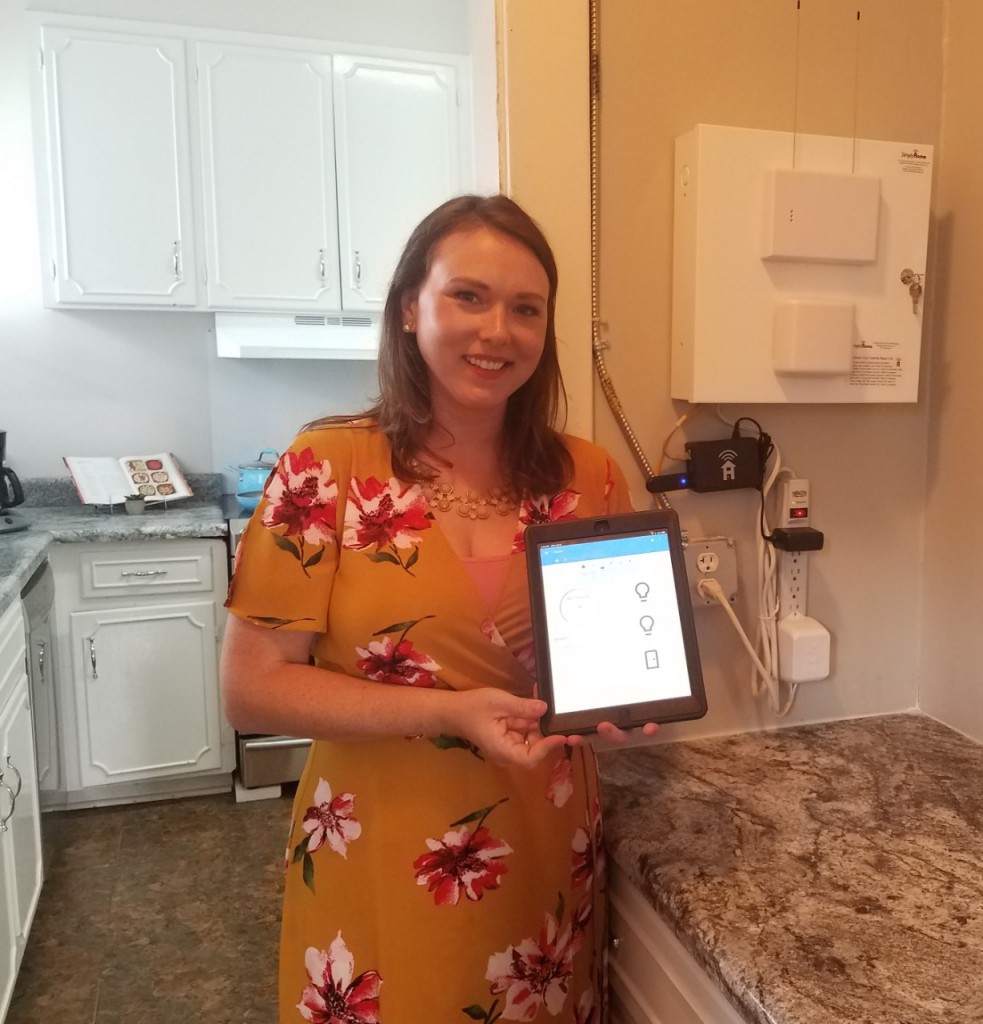When my Council colleague, Mildred Sparkman, and I quietly walked up to the back door of the Harrington House on Stewarts Ferry Pike, the house already knew we were there. In a gentle and courteous voice, the house spoke to us and invited us inside. Mildred and I entered, a little cautiously – was this a prank, or a perilous scene in a horror movie?
Neither, fortunately. It was just Kate Adams, Enabling Tech Champion for the Department of Intellectual and Developmental Disabilities (DIDD), keying in commands to her iPad from where she was standing in the kitchen. Our approach to the house was no secret – because the house had alerted Kate that there were “people at the back door.” That message, plus the image from a camera positioned above the back door, told her all she needed to know.
Welcome to DIDD’s Enabling Tech Tour, and welcome to the 21st Century in supports for individuals with disabilities. Kate works out of this “smart home,” which is filled with new technology, installed to “enable” someone to live more independently. It is also an effort by state departments and provider agencies across the country to deal with a desperate shortage and extreme turnover of staff who provide supports to people with developmental disabilities.
This matches perfectly with the “SimplyHome” mission. SimplyHome is a company that designs and installs technology to help care for those with disabilities and the aging. From its brochure, SimplyHome strives to “empower individuals while addressing the concerns of caregivers and family members.”
Entire smart house systems can be customized to fit an individual’s specific needs and desires. It can be changed or updated as needs change, or as technology progresses. As part of the process of incorporating technology as a means of support, DIDD schedules three planning and preparation meetings with the individual, family members, support staff, and tech experts.
The system is also responsive to those who are concerned about a person’s privacy being compromised. Cameras are only placed in appropriate areas, and the home owner or occupant can decide how much access people can have remotely. Your mom calls late at night or too often and intrudes on your personal time? You can disconnect her call. You need help with something? Someone can be summoned 24/7. If you’re doing fine and don’t need anything, you are in control.
Most of the “smart” technology in this home was not developed for a disability-specific market, which helps to make it affordable. It is a response to a demand by your average consumer who wants to equip her home and life with these modernizing capabilities and conveniences. Many of the products were created by companies like Google, Amazon, and Microsoft. Of course, we’ve been moving in this direction for years: no time to make coffee in the morning? Set a timer the night before and wake up to the smell of fresh brew!
So, let’s look around. The kitchen’s a great place to start. There’s a smart refrigerator that has a large touch screen on the outside of the door, which can help you manage your calendar and communications with remote family members or support staff, while listening to music. You can access your smart devices and appliances from the screen; set lights; talk to someone at your front or back door; even get an alert when your laundry is done. Three internal cameras let you see what’s inside your fridge from a smartphone, in case you went to the store and forgot to make a list of needed items.
There’s a “smart” microwave, too. There’s an induction stove which cooks food with special cookware that only heats the food, not the cooking surfaces, preventing burns. There’s a medication dispenser that sends out just the required dosage, and emits warnings if the meds have not been taken at their scheduled times.
Beyond the kitchen, the house is installed with “smart” locks, for those who have trouble keeping track of their keys, or have physical limitations for opening and closing doors. It can also tell you, remotely, if you’ve left a door unlocked or ajar. There are Alexa-type units in all the major rooms, upstairs and downstairs, for communication, information, setting up deliveries, and even conversation. There are sensors that turn lights on or off. There are lights in the ceiling that can be programmed to provide different alerts to a homeowner who cannot hear, by changing colors or flashing. There are motion detectors, and even a sensor that can let the occupant or his support staff know there’s water on the bathroom floor, to avoid a bad fall.
But what if the power goes out? “We discuss this in the planning process before technology is ever put into a home,” said Kate. “A detailed plan is made to address the following: Who will be alerted? How will they be alerted? How will they respond? How quickly will the response occur? We try to prepare for these things on the front end to avoid troubles on the back end.”
I have only touched the surface of what’s possible through technology to ensure independence, safety, and privacy. In fact, I have only touched the surface of what’s actually installed in this smart Harrington House! To learn more about DIDD’s Enabling Technology program, visit https://www.tn.gov/didd/for-consumers/enabling-technology.html.
To talk with Kate Adams or to schedule a tour of Harrington House, call 615-626-0455 or email kate.adams@tn.gov. For a “smart” home tour in Greeneville, contact Milton Neuenschwander at 865-549-7831 or milton.neuenschwander@tn.gov.
This article first appeared in Breaking Ground Magazine, Issue #99.

Speak Your Mind